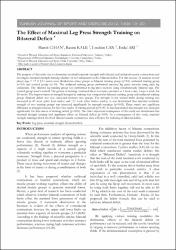| dc.contributor.author | Cihan, Hamit | |
| dc.contributor.author | Kale, Rasim | |
| dc.contributor.author | Can, İbrahim | |
| dc.contributor.author | Arı, Erdal | |
| dc.date.accessioned | 2014-09-15T06:25:22Z | |
| dc.date.available | 2014-09-15T06:25:22Z | |
| dc.date.issued | 2012 | |
| dc.identifier.issn | 1300-9915 | |
| dc.identifier.uri | https://app.trdizin.gov.tr/makale/TVRRNE9UWTVPUT09 | |
| dc.description.abstract | The purpose of this study was to determine maximal isometric strength with bilateral and unilateral muscle contractions and investigate maximal strength training whether or not influenced on this bilateral deficit. For this reason, 34 amateur soccer player (age = 17 ± 2.51 years) were divided into three groups as bilateral training group (n=14), unilateral training group (n=10) and control group (n=10). The unilateral training group performed maximal leg press exercise using each leg unilaterally. The bilateral leg training group was performed to leg press exercise using simultaneously bilateral legs. The control group wasn&#8217;t trained. The groups in training continued these resistance exercises as 1 hour a day, 3 days a week, for 12 weeks. The improvement in strength brought by training was compared as bilateral training group and unilateral training group. Bilateral deficit also was calculated between two groups. The strength in the trained limbs during training was measured in 4th weak (after four weeks) and 12th weak (after twelve weeks). It was determined that maximal isometric strength of two training groups was increased significantly by strength trainings (p<0.05). There wasn&#8217;t any significant difference at strength increase for first four weeks of training period (p>0.05). It was determined that strength was increased significantly for final weeks of training period (p<0.05). The other important consequence of this study was determined that maximal strength training had significant effect on bilateral deficit (p<0.05). As a consequence of this study, maximal strength trainings which involved bilateral muscle contractions were effective for reducing of bilateral deficit. | en_US |
| dc.language.iso | eng | en_US |
| dc.relation.ispartof | Selçuk Üniversitesi Beden Eğitimi ve Spor Bilim Dergisi | en_US |
| dc.rights | info:eu-repo/semantics/openAccess | en_US |
| dc.subject | Leg Press | en_US |
| dc.subject | Maximal Strength | en_US |
| dc.subject | Bilateral Deficit | en_US |
| dc.title | The effect of maximal leg press strength training on bilateral deficit | en_US |
| dc.type | article | en_US |
| dc.relation.publicationcategory | Makale - Ulusal Hakemli Dergi - Kurum Öğretim Elemanı | en_US |
| dc.department | Gümüşhane Üniversitesi | en_US |
| dc.identifier.volume | 14 | en_US |
| dc.identifier.issue | 3 | en_US |
| dc.identifier.startpage | 13 | en_US |
| dc.contributor.institutionauthor | [Belirlenecek] | |
| dc.identifier.endpage | 20 | en_US |


















